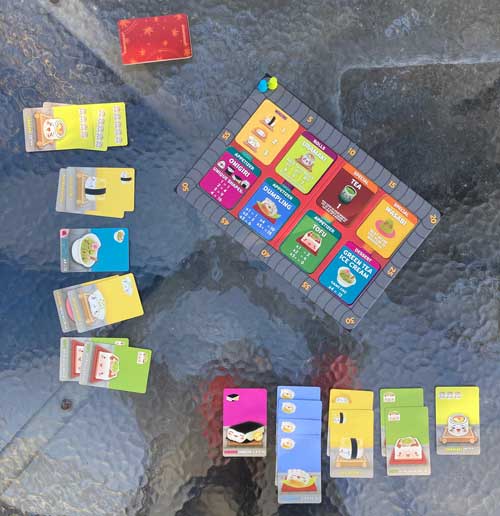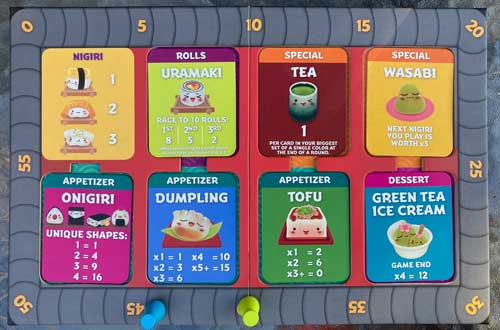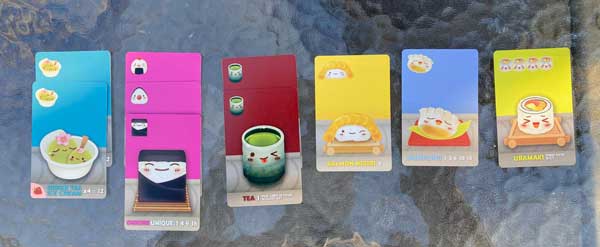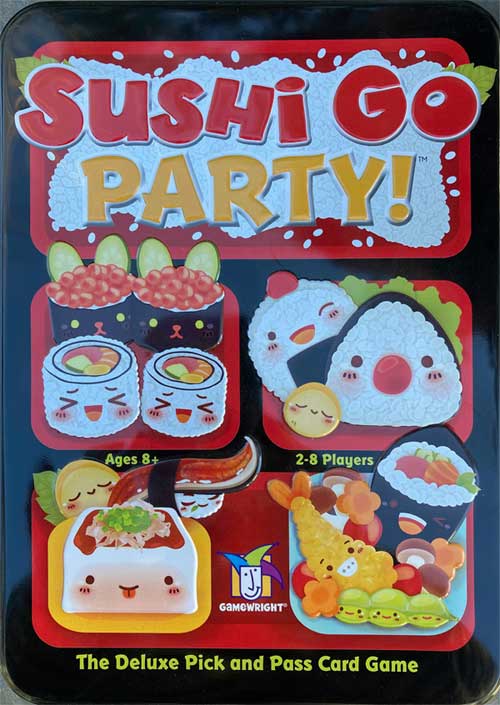Sushi Go Party! is a game published by Gamewright. The premise of the game is for players to collect the best sets of sushi cards to score the most points. The game end is triggered at the end of three rounds. After all points have been counted, the player with the most points is declared the winner.
This post is broken into the following 3 sections, feel free to jump directly to one:
- General summary - consisting of information about overall enjoyment, theme, replayability, and upgrades
- Complexity - consisting of information about the rulebook, setup, player turns, and overall learning curve
- Player turns - consisting of game type, game flow, rule you are likely to miss, and favorite aspect
General Summary
Number of players we had: 4
Our play time (not including setup): 25 minutes
Table size needed: Small, 3'-4'
Overall enjoyment

Overall our group really enjoys playing this game. I previously reviewed the original Sushi Go! game, but the deluxe party game is different enough that it warrants its own review. The deluxe game introduces many more cards, new point mechanisms, a game board, and the ability to customize each game. All the artwork for the new cards is unique yet matches the theme of the original game perfectly.
Sushi Go Party! also comes with a dual-layered player board that serves two purposes: holding the thick menu tiles that match the cards chosen for that particular game, and to track player points around the outside edge at the end of each round.
We really like the additional variability provided by the deluxe game. Some menu items are more challenging than others which means players set up a simpler game or choose more complex menu items for seasoned players. Lastly, the deluxe version allows for up to eight players versus the maximum of five players in the original game.
Theme

The theme of Sushi Go Party! is even better than the original because there are so many more menu items. My favorite cards are the onigiri. Within the onigiri there are four different shapes, each with the cutest faces. We also love the bright colors used in the background of many of the cards. These colors make it easy to see the different menu items and also give a light and fun feel to the game.

Replayability

Sushi Go Party! has lots of replayability because it introduces so many new types of cards, and players can create their own unique deck each game. New card types include:
- Two new types of rolls.
- Five new types of appetizers.
- Two new types of desserts.
- Six new types of specials.
Also, with more cards and the ability to play with up to eight players, Sushi Go Party! can be played with much bigger player groups and is still appropriate for families and any player group. Since the game now includes a main board, the box is substantially bigger than the original. However, the original game was so compact, that this game is still much smaller than many board games and I still consider it extremely portable.
Upgrades
I am not aware of any upgrades for Sushi Go Party!. If you are looking for something more portable and do not have more than 5 players, you may want to try the original game, Sushi Go!. For more information about that game, read our game play review.
Complexity
Rule book
The rule book is well organized with lots of images and an overview of how the rounds are played. There are also detailed explanations of how each menu item works including how each one scores points.
One cool thing about the rule book is that there are eight example menus for setting up a game with descriptions for when each is good to use. For example, there is an example menu for first time players as well as menus for playing with new cards, high scoring games, and more. Players can also pick their own custom menu at any time, though it will always consist of one type of roll, three appetizers, two specials, one dessert and the nigiri cards. Still, the example menus are nice, especially if you are in the mood to play but don't feel like overthinking your menu!
Setup
Setting up a game takes about five minutes. Players pick one type of roll, three appetizers, two specials and a dessert item for their menu. The matching menu tiles are placed into their corresponding slots on the dual-layered board and the matching cards create the game deck. Each player then picks a player pawn and after separating out the dessert cards for each round as instructed, players are ready to begin.

Turns
Turns go very fast as all players are simultaneously choosing one card from their hand to keep and place in their play area. Once every player has chosen a card, they reveal at the same time before passing their remaining cards to the player next to them. Players then repeat this process until there are no more cards to pass and that round is scored. This process repeats for a total of three rounds.
Overall learning curve
The overall learning curve of this game is very low. Sushi Go Party! includes many new card types, each with its own way of scoring points, but none of them are overly complex or difficult. For example, the tofu appetizer card provides two points for any player with one at the end of a round, six points for any player with two at the end of a round or zero points for any players with three or more at the end of a round.
Player Turns
Play type
Sushi Go Party! is a symmetrical card drafting game where players gain points based on collecting sets of cards. Like the original, players' have no idea what cards are in other players hands. This means everyone is making their best guess at what might be available during the round each time they pick a card.
Sometimes players are selecting cards to increase their own set, while other times they keep a card to prevent another player from having it. Still other times a player passes a card because it can hurt their game if they end up with it or provide no value at all - like a third tempura card which does nothing since they only score in pairs.

Game flow
The flow of this game is fast and very fun. Turns are taken simultaneously, and players are not only thinking about their own strategies, but also what other players are doing. Sometimes you can choose to pass on a card and be lucky enough to claim it when that same hand gets back to you. Other times the card you wanted will be claimed by another player. In this way, players must constantly adapt their game strategy which is half the fun.
Rule you are likely to forget/miss
The one rule you are likely to forget or miss in Sushi Go Party! is to separate out the dessert cards for each round and only shuffle in the appropriate amount at the beginning of each round. This is very different than the original game where all the dessert cards are mixed in from the beginning.
Favorite aspect
Our favorite aspect of this game is that while it is simple in design and rules, there are enough complexities and variety in point scoring that players really do need to pay attention and consistently adapt if they want a shot at winning.
We also really like how easy it is to track the different menu items and their scoring, even when you don't have those cards in your hand, because of the player board holding the menu tiles for the current game. This really does add to the game and makes it easy to play with the new menu items without being overwhelmed by trying to remember how each menu item works.
We have had Sushi Go Party! in our collection for several years and we enjoy playing this game every time we play it. Everyone we have ever played it with also enjoys it and it is a very portable game that can be played with families or any player group. We will definitely keep this game on our shelves for a long time to come.


